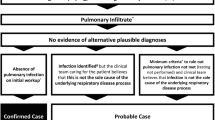Abstract
Purpose. To examine the effect of formulation type on the aerosolization of respirable particles in narrow size distributions.
Methods. Aerosol dispersion of two formulation types (drug alone and 2% w/w drug-lactose blends) containing micronized or spray-dried fluticasone propionate (FP) particles (d50% = 1.3 to 9.6 μm, GSD = 1.8 to 2.2) were examined using cascade impaction at 60 L/min with low and high resistance inhaler devices: Rotahaler and Inhalator, respectively.
Results. The aerosol dispersion of FP particles was significantly affected by the particle size, particle type, inhaler device, and formulation type. Interactions were observed between all factors. Generally, greater powder entrainment was obtained with smaller d50%. Higher emitted doses were obtained from drug-alone formulations of spray-dried FP particles and lactose blends of micronized FP particles. Greater aerosol dispersion of spray-dried FP particles was obtained using lactose-blend formulations with d50% around 4 μm. Greater aerosol dispersion of micronized FP particles was obtained using formulations of drug alone. Larger d50% produced larger mass median aerodynamic diameters.
Conclusions.Small changes in the particle size within the 1-10-μm range exerted a major influence on aerosol dispersion of jet-milled and spray-dried FP particles using drug-alone and lactose-blend formulations.
Similar content being viewed by others
References
P. R. Byron. Prediction of drug residence times in regions of the human respiratory tract following aerosol inhalation. J. Pharm. Sci. 75:433-438 (1986).
N. Chew and H.-K. Chan. Influence of particle size, air flow and inhaler device on the dispersion of mannitol powders as aerosols. Pharm. Res. 16:1098-1103 (1999).
N. Y. K. Chew, D. F. Bagster, and H.-K. Chan. Effect of particle size, air flow and inhaler device on the aerosolisation of disodium cromoglycate powders. Int. J. Pharm. 206:75-83 (2000).
M. D. Louey, M. Van Oort, and A. J. Hickey. Aerosol dispersion of respirable particles in narrow size distributions produced by jet-milling and spray-drying techniques. Pharm. Res.
N. M. Kassem, K. K. L. Ho, and D. Ganderton. The effect of air flow and carrier size on the characteristics of an inspirable cloud. J. Pharm. Pharmacol. 41:14P(1989).
M. A. Braun, R. Oschmann, and P. C. Schmidt. Influence of excipients and storage humidity on the deposition of disodium cromoglycate (DSCG) in the twin impinger. Int. J. Pharm. 135:53-62 (1996).
H. Steckel and B. W. Müller. In vitro evaluation of dry powder inhalers II: influence of carrier particle size and concentration on in vitro deposition. Int. J. Pharm. 154:31-37 (1997).
N. M. Kassem and D. Ganderton. The influence of carrier surface on the characteristics of inspirable powder aerosols. J. Pharm. Pharmacol. 42:11P(1990).
Y. Kawashima, Takanori Sarigano, Tomoaki Hino, Hiromitsu Yamoto, and Hirofumi Takeuchi. Effect of surface morphology of carrier lactose on dry powder inhalation property of pranlukast hydrate. Int. J. Pharm. 172:179-188 (1998).
D. Ganderton. The generation of respirable clouds from coarse powder aggregates. J. Biopharm. Sci. 3:101-105 (1992).
P. Lucas, K. Anderson, and J. N. Staniforth. Protein deposition from dry powder inhalers: fine particle multiplets as performance modifiers. Pharm. Res. 15:562-569 (1998).
X. M. Zeng, Xian Ming Zeng, Gary Peter Martin, Seah-Kee Tea, and Christopher Marriot. The role of fine particle lactose on the dispersion and deaggregation of salbutamol sulphate in an air stream in vitro. Int. J. Pharm. 176:99-110 (1998).
A. J. Hickey and N. M. Concessio. Flow properties of selected pharmaceutical powders from a vibrating spatula. Particle and Particle Systems Characterization (11):457-462 (1994).
T. M. Crowder and A. J. Hickey. An instrument for rapid powder flow measurement and temporal fractal analysis. Particle and Particle Systems Characterization (16): 32-34 (1999).
I. Gonda. Targeting by deposition. In A. J. Hickey (ed.), Pharmaceutical Inhalation Aerosol Technology, Marcel Dekker, Inc., New York, 1992, pp. 61-82.
W. C. Hinds. Uniform particle motion. In Aerosol Technology. Properties, Behavior, and Measurement of Airborne Particles, Wiley-Interscience, New York, 1982, pp. 38-68.
B. H. Kaye. A Random Walk Through Fractal Dimensions, VCH Publishers, Weinheim, 1989.
A. R. Clark and A. M. Hollingworth. The relationship between powder inhaler resistance and peak inspiratory conditions in healthy volunteers—implications for in vitro testing. J. Aerosol Med. 6:99-110 (1993).
Author information
Authors and Affiliations
Corresponding author
Rights and permissions
About this article
Cite this article
Louey, M.D., Van Oort, M. & Hickey, A.J. Aerosol Dispersion of Respirable Particles in Narrow Size Distributions Using Drug-Alone and Lactose-Blend Formulations. Pharm Res 21, 1207–1213 (2004). https://doi.org/10.1023/B:PHAM.0000032991.74736.3e
Issue Date:
DOI: https://doi.org/10.1023/B:PHAM.0000032991.74736.3e




